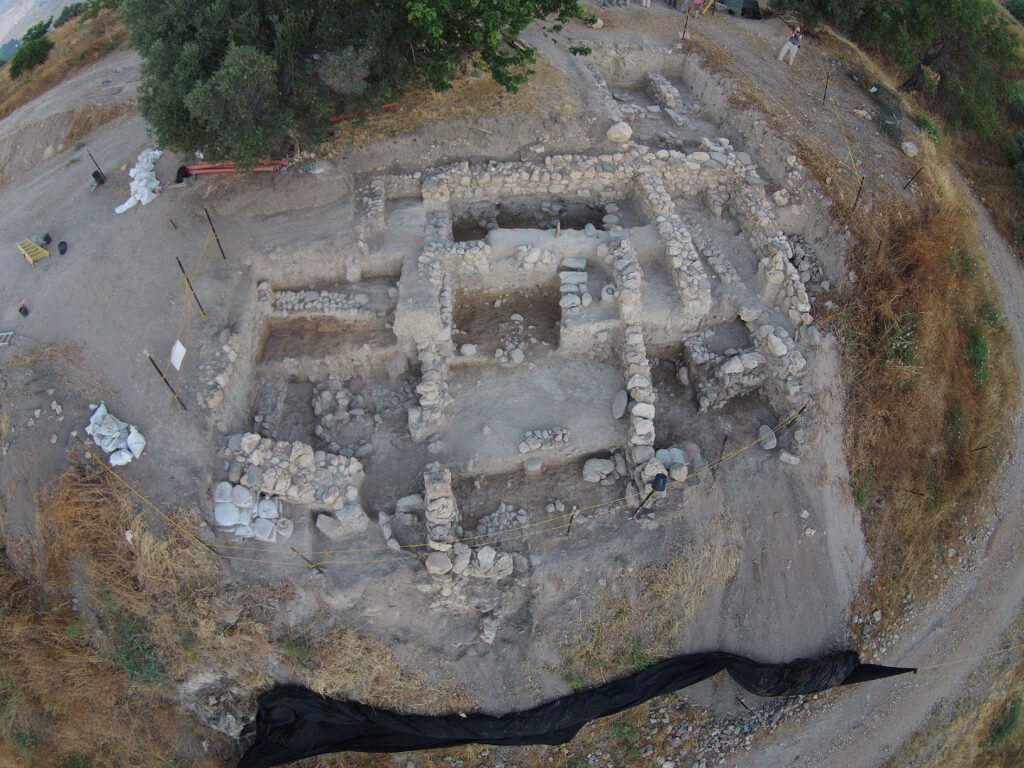Tel Abel Beth Maacah is a large multi-layered tell located in the Upper Galilee, northern Israel.
The tel is located in the Upper Galilee, near the city of Metula, and overlooks the road going north to the Syrian-Phoenician valley. The area of the site is about 100 dunams, and on a large part of it, there are buildings belonging to the village of Abil al-Qamh, which was abandoned in 1948. The site was identified in the 19th century and excavations started in 2013 by the Hebrew University. The earliest remains of human activity at Beth Maacah are from the Early Bronze Age 2, and soon afterward it became a patron city of the kingdom of Hazor. During the Iron Age, the city gained geopolitical importance as a connecting factor between Phoenicia, Aram, and the Kingdom of Israel. A military citadel and imported Phoenician vessels were found on the site, as well as an unusual find of a jug containing 400 animal ankle bones, which were mostly used for playing/divination.


Abel Beth Maacah is mentioned 3 times in the Bible: in the story of the wise woman who saved the city during the time of King David (10th century BCE) by convincing Sheba ben Bakri, who fled to it after an attempt to rebel against the king, to hand himself over to Yoav ben Zeruiah who besieged the city. Other biblical references are found in 1 Kings 15:20, during the Armenian conquest in the 9th century BCE by Ben Hadad I, and in the Assyrian conquest in the 8th century BC by Tiglath Pileser III (2 Kings 15:29).
The Bible even refers to a kingdom called “Maacah” several times, but no clear link to the city has yet been found. There is a dispute in the research on the question of whether Maacah was an Aramaic city (together with the city of “Geshur”), or alternatively a Canaanite cultural entity that over time became an appendage of the Aramaic kingdom in the Iron Age 2. Prof. Israel Finkelstein claims that the name Abel Beth Maacah refers to an Aramaic city, while Prof. Nadav Naaman claims that the city was the capital of the Canaanite kingdom of Maacah. An extra-biblical reference to the city of “Abel” (“Beth Maacah” was probably added later) appears in writings from the 18th century BCE and the list of cities of Thutmose III’s from the 15th century BCE.
History of the excavations
The site was surveyed by William Dever and the Antiquities Authority in 1973 but was systematically excavated beginning in 2013 by a Hebrew University delegation led by Naama Yahalom-Mack and Nava Panitz-Cohen, in collaboration with Azusa Pacific University led by Robert Mullins. The expedition lasted 10 excavation seasons.
The Bronze Age
The earliest settlement findings are from the Middle Bronze Age 2B, from this period impressive fortifications and many buildings were found which led the excavators to hypothesize that Abel Beth Maacah, which is located next to the cities of Dan and Hazor, was a patron city of the great kingdom of Hazor. According to the excavations, the fall of Hazor in the 13th century BCE was the cause of the arrival of new populations and economic opportunities to Abel Beth Maacah and led to the expansion and prosperity of the city.
The Iron Age
According to the study, during the Iron Age Abel Beth Maacah played an important geopolitical role from a regional point of view, because it was located on a route connecting Phoenicia, Aram and the Kingdom of Israel. Evidence of this can be found in the Phoenician influences on tools and figurines found on the site from this period
The Iron Age is quite evident at the site and includes a military citadel, a ritual building and an industrial complex where imported Phoenician vessels were found. An unusual find was also found in a jar that contained over 400 ankle bones (astragali) that are usually used as game dice or for divination. Analyses found that the bones came from goats, deer and sheep and some of them had holes drilled in them. From this period a unique head in the form of a bearded man made of ceramic covered with glaze (faience) was found, apparently Egyptian.
Late Periods
In the excavations, an impressive stone structure from the Persian period and small finds mainly from the Hellenistic-Roman periods were found. From the Mamluk period, mainly tombs were found on the site. Evidence of a settlement in later periods – Crusader and Ottoman – was also found. The village of Abil al-Qamh was built over a large part of the hill during the Mamluk period, and it was populated until 1948.
Bibliography
Nama Yahalom-Mack, Nava Panitz-Cohen, and Robert Mullins. 2018. From a Fortified Canaanite City-State to “a City and a Mother” in Israel: Five Seasons of Excavation at Tel Abel Beth Maacah. Near Eastern Archaeology, Vol. 81, No. 2, pp. 145-156.
Excavations website: Tel Abel Beth Maacah Excavations
Biblical Hiking map

